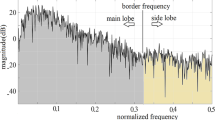Summary
Muscular fatigue was studied in the human m. biceps brachii by contracting the muscle as long as possible at 50% of maximum voluntary strength. For 8 subjects changes in the muscle fibre action potential conduction velocity could successfully be measured using the cross-correlation technique between two surface EMG signals. Shifts in the EMG power spectrum were quantified using the mean power frequency (MPF) of the EMG power spectral density function.
During fatigue the EMG power spectrum gradually shifted to lower frequencies. The mean value and standard deviation of the MPF value decreased from (115±20) Hz at the beginning of the experiment to (60±18) Hz at the end. For 4 of the 8 subjects the decrease in MPF value was accompanied by a substantial decrease in conduction velocity (mean decrease was 33% of the initial velocity value). For the other 4 subjects, despite the great MPF changes, there was hardly any change in conduction velocity (mean decrease was 3%).
The present study shows that great EMG power spectral shifts during muscular fatigue may occur without a concomitant change in muscle fibre action potential conduction velocity.
Similar content being viewed by others
References
Basmaijan JV (1980) Electromyography — Dynamic gross anatomy: a review. Am J Anat 159: 245–260
Bendat JS, Piersol AG (1971) Random data: analysis and measurement procedures. Wiley — Interscience, New York
Bigland-Ritchie B, Donovan EF, Roussos CS (1981) Conduction velocity and EMG power spectrum changes in fatigue of sustained maximal efforts. J Appl Physiol-Respirat Environ 51: 1300–1305
Blank A, Gonen B, Masora A (1979) The size of active motor units in the initiation and maintenance of an isometric contraction carried out to fatigue. Electromyogr Clin Neurophysiol 19: 535–539
Blinowska K, Piotrkiewicz M (1978) A study of surface electromyograms by the means of digital simulation. II. Spectral analysis of simulated and experimental electromyograms. Electromyogr Clin Neurophysiol 18: 95–105
Buchthal F, Guld C, Rosenfalck P (1955) Innervation zone and progagation velocity in human muscle. Acta Physiol Scand 35: 174–190
Clamann HP (1970) Activity of single motor units during isometric tension. Neurology 20: 254–260
De Luca CJ (1979) Physiology and mathematics of myoelectric signals. IEEE Trans Biomed Engineer 26: 313–325
Frisk-Holmberg M, Jörfeldt L, Juhlin-Dannfelt A, Karlsson J (1981) Leg blood flow during excercise in man in relation to muscle fibre composition. Acta Physiol Scand 112: 339–342
Gydikov A, Dimitrova N, Kosarov D, Dimitrov G (1976) Influence of frequency and duration of firing on the shape of potentials from different types of motor units in human muscles. Exp Neurol 52: 345–355
HÄgg G (1981) Electromyographic fatigue analysis based on the number of zero crossings. Pflügers Arch Physiol 391: 78–80
Kwatny E, Thomas D, Kwatny HG (1970) An application of signal processing techniques to the study of myoelectric signals. IEEE Trans Biomed Engineer 17: 303–313.
LindstrØm L, Magnusson R, Petersen I (1970) Muscular fatigue and action potential conduction velocity changes studied with frequency analysis of EMG signals. Electromyography 4: 341–356
LindstrØm L, Kadefors R, Petersen I (1977) An electromyographic index for localized muscle fatigue. J Appl Physiol: Respirat Environ Exerc Physiol 43: 750–755
Lippold OCJ, Redfearn JWT, Vuco J (1960) The electromyography of fatigue. Ergonomics 3: 121–131
Maton B (1981) Human motor activity during the onset of muscle fatigue in submaximal isometric isotonic contraction. Eur J Appl Physiol 46: 271–281
Naeije M, Zorn H (1981) Changes in the power spectrum of the surface electromyogram of the human masseter muscle due to local muscular fatigue. Arch Oral Biol 26: 409–412
Naeije M, Zorn H (1982) Estimation of the action potential conduction velocity in human skeletal muscle using the surface EMG cross-correlation technique. Electromyogr Clin Neurophysiol (in press)
Papoulis A (1973) Minimum-bias windows for high resolution spectral estimates. IEEE Trans Informat Theory 19: 9–12
Person RS, Mishin LN (1964) Auto- and cross-correlation analysis of the electrical activity of muscles. Med Electron Biol Engineer 2: 155–159
Person RS, Kudina LP (1968) Cross-correlation of electromyogram showing interference pattern. Electroenceph Clin Neurophysiol 25: 58–68
Person RS, Libkind MS (1970) Simulation of electromyograms showing interference patterns. Electroenceph Clin Neurophysiol 28: 625–632
Stålberg E (1966) Propagation velocity in human muscle fibres in situ. Acta Physiol Scand 287: 3–112
Stulen FB, De Luca CJ (1981) Frequency parameters of the myoelectric signal as a measure of muscle conduction velocity. IEEE Trans Biomed Engineer 28: 515–523
Viitasalo JHT, Komi PV (1977) Signal characteristics of EMG during fatigue. Eur J Appl Physiol 37: 111–121
Author information
Authors and Affiliations
Rights and permissions
About this article
Cite this article
Naeije, M., Zorn, H. Relation between EMG power spectrum shifts and muscle fibre action potential conduction velocity changes during local muscular fatigue in man. Europ. J. Appl. Physiol. 50, 23–33 (1982). https://doi.org/10.1007/BF00952241
Accepted:
Issue Date:
DOI: https://doi.org/10.1007/BF00952241




